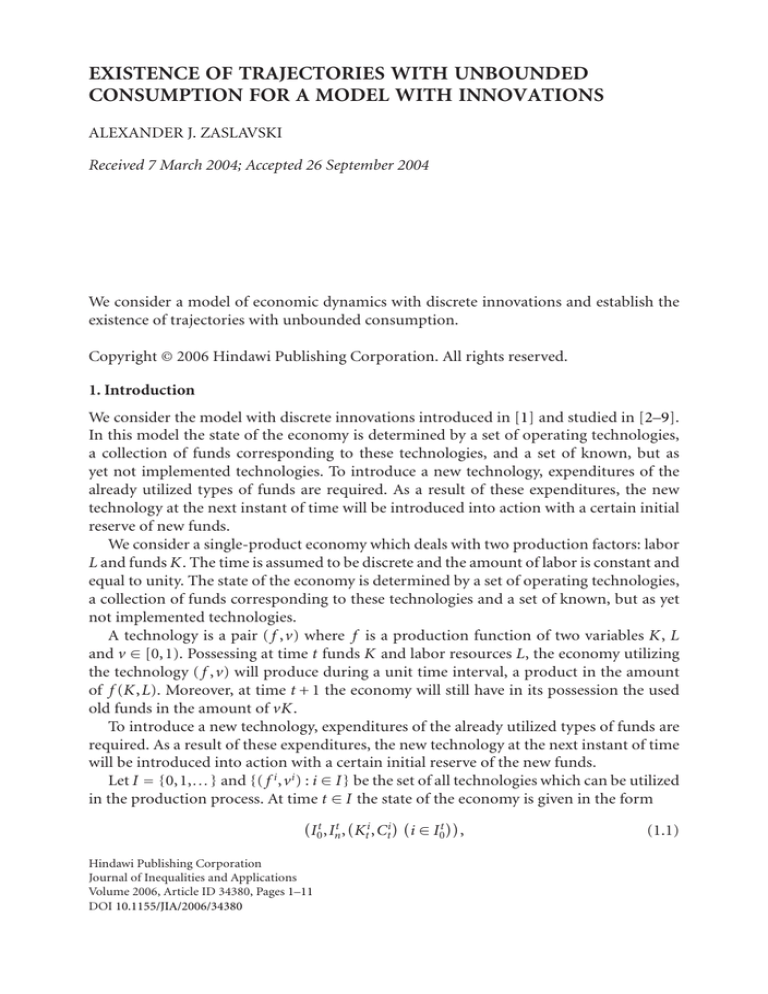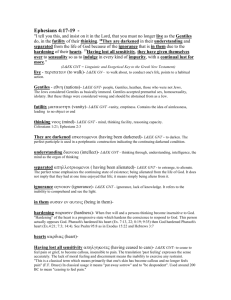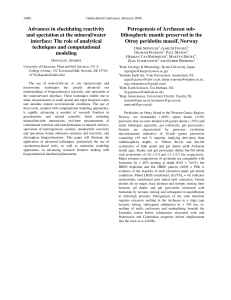
EXISTENCE OF TRAJECTORIES WITH UNBOUNDED
CONSUMPTION FOR A MODEL WITH INNOVATIONS
ALEXANDER J. ZASLAVSKI
Received 7 March 2004; Accepted 26 September 2004
We consider a model of economic dynamics with discrete innovations and establish the
existence of trajectories with unbounded consumption.
Copyright © 2006 Hindawi Publishing Corporation. All rights reserved.
1. Introduction
We consider the model with discrete innovations introduced in [1] and studied in [2–9].
In this model the state of the economy is determined by a set of operating technologies,
a collection of funds corresponding to these technologies, and a set of known, but as
yet not implemented technologies. To introduce a new technology, expenditures of the
already utilized types of funds are required. As a result of these expenditures, the new
technology at the next instant of time will be introduced into action with a certain initial
reserve of new funds.
We consider a single-product economy which deals with two production factors: labor
L and funds K. The time is assumed to be discrete and the amount of labor is constant and
equal to unity. The state of the economy is determined by a set of operating technologies,
a collection of funds corresponding to these technologies and a set of known, but as yet
not implemented technologies.
A technology is a pair ( f ,v) where f is a production function of two variables K, L
and v ∈ [0,1). Possessing at time t funds K and labor resources L, the economy utilizing
the technology ( f ,v) will produce during a unit time interval, a product in the amount
of f (K,L). Moreover, at time t + 1 the economy will still have in its possession the used
old funds in the amount of vK.
To introduce a new technology, expenditures of the already utilized types of funds are
required. As a result of these expenditures, the new technology at the next instant of time
will be introduced into action with a certain initial reserve of the new funds.
Let I = {0,1,... } and {( f i ,vi ) : i ∈ I } be the set of all technologies which can be utilized
in the production process. At time t ∈ I the state of the economy is given in the form
I0t ,Int , Kti ,Cti
Hindawi Publishing Corporation
Journal of Inequalities and Applications
Volume 2006, Article ID 34380, Pages 1–11
DOI 10.1155/JIA/2006/34380
i ∈ I0t ,
(1.1)
2
Existence of trajectories
where I0t is a finite set of numbers (indices) of technologies introduced by the time t, Int
is the set of numbers of technologies which are available in principle but not introduced,
and Kti ,Cti ≥ 0 are the funds and consumption of the ith type available at time t which correspond to the technology with the number i. We will assume that at time t, the following
information is available:
ij
Ki ,
s
i ∈ Int , j ∈ Int ∪ I0t ,
(1.2)
where si j ≥ 0 is the expenditure of the jth funds required for introduction of the ith
technology and K i > 0 is the initial amount of the ith fund which is obtained at the initial
time of utilization of the ith technology. At time t + 1 the economy may pass over to the
state
i
i
I0t+1 ,Int+1 , Kt+1
,Ct+1
i ∈ I0t+1
(1.3)
for which
I0t ⊂ I0t+1 ⊂ I0t ∪ Int ,
I0t+1 \ I0t ⊂ i ∈ Int : si j = 0 ∀ j ∈ Int
(1.4)
and the numbers Lit ≥ 0, i ∈ I0t are determined such that
i∈I0t
j
Lit ≤ 1,
j
Kt+1 ≥ v j Kt
i
= K i,
Kt+1
j
j
∀ j ∈ I0t ,
i
Ct+1
= 0,
j
Kt+1 − v j Kt + Ct+1 +
i∈I0t+1 \I0t
i ∈ I0t+1 \ I0t ,
j
j
si j ≤ f j Kt ,Lt
(1.5)
∀ j ∈ I0t .
(We assume here that the result of a summation over an empty set equals zero.) Note that
in the model under consideration the newly produced product is used for consumption
and expenditures related to an introduction of new technologies. Sometimes the state of
the economy at time t will be written in the form
I0t ,Int , Kti ,Cti ,Lit
i ∈ I0t ,
(1.6)
where (Lit ) (i ∈ I0t ) is the distribution of labor resources at time t. We do it in the case
when some description of this distribution is required. When describing a trajectory of
the model we would also include into its description the corresponding sequence of distributions of labor resources, most often only in the case when some information about
these resources is required. However, in any case a definite sequence of distributions of
labor resources is always associated with a trajectory of the model.
Denote by Rl+ the cone of elements of the Euclidean space Rl with nonnegative coordinates. Below all the technologies under consideration ( f ,v) will assume to be such
that f : R2+ → R+ be a continuous, superlinear (superadditive, positively homogeneous)
Alexander J. Zaslavski 3
function,
f (0,1) = f (1,0) = 0,
f (x,1) < f (λx,1) < λ f (x,1) for each λ > 1 and each x > 0,
(1.7)
and there exists X ∈ R+ such that f (1,X) > 1 − v.
Let ( f ,v) be a technology. It is easy to see that there exists a unique number x( f ,v) > 0
such that
f x( f ,v),1 = (1 − v)x( f ,v).
(1.8)
For x0 > 0 the inequality f (x0 ,1) > (1 − v)x0 holds if and only if x0 < x( f ,v) and the
sequence
xt = vxt−1 + f xt−1 ,1 ,
t = 1,2,...
(1.9)
converges to x( f ,v) as t → ∞. Evidently x( f ,v) is a characteristic of the technology ( f ,v)
which evaluates its production capabilities.
The technology ( f ,v) is associated with a dynamic model of the economy whose trajectory is a sequence (Kt ,Ct ), t = 0,1,..., where Kt ,Ct ≥ 0 are the funds and consumption
available at time t which satisfy
Kt+1 − vKt ≥ 0,
Kt+1 − vKt + Ct+1 ≤ f Kt ,1
(1.10)
for all t = 0,1,....
It is easy to see that for any model trajectory (Kt ,Ct ), t = 0,1,... we have
limsup vKt + f Kt ,1
t →∞
≤ x( f ,v),
(1.11)
limsup Kt ≤ x( f ,v).
t →∞
Moreover, for any initial state of the model (K0 ,C0 ) with K0 > 0 there exists a trajectory
(Kt ,Ct ), t = 0,1,... such that Kt → x( f ,v) as t → ∞.
Let X = (Kt ,Ct ) (t ∈ I) be a model trajectory. Set
w(X) = limsup T −1
T →∞
T
−1
t =0
Ct .
(1.12)
Evidently w(X) ≤ x( f ,v). Set
w( f ,v) = sup w(X) : X is a model trajectory .
(1.13)
The number w( f ,v) is a characteristic of the technology ( f ,v) which evaluates its consumption capabilities.
It is easy to verify that the following result is true.
4
Existence of trajectories
Proposition 1.1. There exists a number h( f ,v) ∈ (0,1) such that
lim h( f ,v) f (1,x) ∈ (1 − v, ∞],
x→∞
1 − h( f ,v) f x h( f ,v) f ,v ,1 = w( f ,v) > 0.
(1.14)
2. The main result
Consider the model with discrete innovations introduced in Section 1. We assume that
for each i, j ∈ I
si j > 0 if and only if i = j + 1
(2.1)
and that
s(i+1)i < f i x f i ,vi ,1
(2.2)
for each i ∈ I.
Remark 2.1. Let i ∈ I and the ith technology be introduced at time t0 . Assume that K i <
x( f i ,vi ). This inequality means that the initial amount of the ith fund is less than the
characteristic of the technology ( f i ,vi ) which evaluates its production capabilities. It is
easy to see that for each instant of time t > t0 , Kti < x( f i ,vi ) and f i (Kti ,1) < f i (x( f i ,vi ),1).
Therefore the inequality (2.2) is necessary for implementation of the (i + 1)th technology.
It is well known that for a model with a finite number of technologies all trajectories
are bounded. For the model with discrete innovations a finite number of technologies
can be introduced by time t, where t = 0,1,..., but the set of all technologies which can
be utilized in the production process is infinite. In [2] we established the existence of trajectories of the model with discrete innovations on which consumption tends to infinity
if the set {w( f i ,vi ) : i ∈ I } is unbounded and if
−1
sup s(i+1)i f i x f i ,vi ,1
: i ∈ I < 1.
(2.3)
In this paper we will establish the following result.
Theorem 2.2. Let
sup w f i ,vi : i ∈ I = ∞,
I00 ,In0 , K0i ,C0i
I ∈ I00
(2.4)
be an initial state of the economy and let
p
p = sup i : i ∈ I00 ,
K0 > 0.
(2.5)
Then there exists a model trajectory
I0t ,Int , K0i ,C0i
i ∈ I0t
(t ∈ I),
(2.6)
Alexander J. Zaslavski 5
such that
T −1
T
t =1
sup Cti : i ∈ I0t −→ ∞
as T −→ ∞
(2.7)
and that for each t > 0, sup{Cti : i ∈ I0t } > 0.
3. Proof of Theorem 2.2
We may assume without loss of generality that for any instant of time t and any state of
the model
I˜0t , I˜nt , K̃ti , C̃it
I ∈ I˜0t ,
(3.1)
the following relation holds:
I˜nt = max i : i ∈ I˜0t + 1 .
(3.2)
In view of this assumption we omit below the notation Int in describing the state of the
model. Clearly, we may also assume without loss of generality that
I00 = { p}.
For i ∈ I we set
(3.3)
w(i) = w f i ,vi ,
h(i) = h f i ,vi ,
x(i) = x f i ,vi ,
Λ(i) = x h f i ,vi f i ,vi .
(3.4)
Set p0 = p. By (2.4) there exists a strictly increasing sequence of integers pi ∈ I, i = 0,1,...
such that
w pi+1 ≥ 2w pi
∀i ∈ I.
(3.5)
For each i ∈ I set
K̃ i = min 4−1 Λ(i), K i .
(3.6)
Let i ∈ I. Set
Γ(i,0) = K̃ i ,
Γ(i, p + 1) = vi Γ(i, p) + f i Γ(i, p),1 ,
p ∈ I.
(3.7)
It follows from (2.2) and (3.7) that there is a natural number q(i) > 2 such that
s(i+1)i < f i Γ i, q(i) − 1 ,1 .
(3.8)
Lemma 3.1. Let τ ∈ I, (I0τ ,(Kτi ,Cτi ) (i ∈ I0τ )) be a state of the economy at time τ and let
j = max i : i ∈ I0τ ,
j
Kτ ≥ K̃ j .
(3.9)
6
Existence of trajectories
Then there exists a model trajectory
I0t , Kti ,Cti
i ∈ I0t
t = τ,...,τ + q( j) ,
(3.10)
such that
τ+q( j)
I0
j+1
= I0τ ∪ { j + 1},
j
Ct > 0,
Kτ+q( j) = K j+1 ,
t = τ + 1,...,τ + q( j).
(3.11)
Proof. Set
−1
l = s( j+1) j f j Γ j, q( j) − 1 ,1
.
(3.12)
For t = τ,...,τ + q( j) − 2 we set
I0t+1 = I0t = I0τ ,
Lit = 0,
i
= 0,
Ct+1
j
Kt+1
j
Ct+1
j
i ∈ I0τ \ { j },
Lt = 1,
i
Kt+1
= v i Kti ,
j
= v j Kt
=f
j
+f
i ∈ I0τ \ { j }.
j
j Kt ,1 −
j
Kt ,(1 + l)/2 ,
j
(3.13)
f j Kt ,(1 + l)/2 .
Clearly the states of the trajectory at times t = τ,...,τ + q( j) − 1 are well defined and
j
Ct > 0,
t = τ + 1,...,τ + q( j) − 1.
(3.14)
We show that
j
f j Kτ+q( j)−1 ,1 > s( j+1) j .
(3.15)
First we show by induction that for t = 0,..., q( j) − 1,
j
Kt+τ ≥ Γ( j,t)(1 + l)/2.
(3.16)
In view of (3.9) and (3.6) the inequality (3.16) is valid for t = 0. Assume that (3.16) holds
with an integer t satisfying
0 ≤ t < q( j) − 1.
(3.17)
It follows from (3.13), (3.16) and (3.7) that
j
j
j
Kt+1+τ = v j Kt+τ + f j Kt+τ ,(1 + l)/2
≥ v j Γ( j,t)(1 + l)/2 + (1 + l)/2 f j Γ( j,t),1
≥ (1 + l)/2 Γ( j,t + 1).
(3.18)
Alexander J. Zaslavski 7
Therefore (3.16) is true for all t = 0,..., q( j) − 1 and
j
Kτ+q( j)−1 ≥ (1 + l)/2 Γ j, q( j) − 1 .
(3.19)
By (3.19), (3.12) and (3.8),
j
f j Kτ+q( j)−1 ,1 ≥ f j 2−1 (1 + l)Γ j, q( j) − 1 ,1
> 2−1 (1 + l) f j Γ j, q( j) − 1 ,1 > s( j+1) j .
(3.20)
Define the state of the economy at time τ + q( j) as follows:
τ+q( j)
I0
j
Lτ+q( j)−1 = 1,
j
Liτ+q( j)−1 = 0,
= I0τ ∪ { j + 1},
i
Cτ+q(
j) = 0,
i ∈ I0τ \ { j },
i
i i
Kτ+q(
j) = v Kτ+q( j)−1 ,
j
j
Kτ+q( j) = v j Kτ+q( j)−1 ,
i ∈ I0τ \ { j },
j
Cτ+q( j) = f j Kτ+q( j)−1 ,1 − s( j+1) j ,
j+1
(3.21)
j+1
Kτ+q( j) = K j+1 ,
Cτ+q( j) = 0.
It is easy to see that the state of the economy at time τ + q( j) is well defined. Lemma 3.1
is proved.
Lemma 3.2. Let τ,k ∈ I and let
I0t , Kti ,Cti
i ∈ I0t
(t = 0,...,τ)
(3.22)
be a model trajectory. Assume that
pk = max i : i ∈ I0τ ,
p
Kτ k
−1
(3.23)
≥ 4 Λ pk .
(3.24)
Then there exists a model trajectory
I0t , Kti ,Cti
i ∈ I0t
(t = τ,...,τ + S)
(3.25)
with an integer S ≥ 1 and an integer T ∈ [1,S) such that
p +1
max i : i ∈ I0τ+S = pk+1 ,
sup Cti : i ∈ I0t > 0,
p
Ct k
Q −1
k
Kτ+S
≥ 4−1 Λ pk+1 ,
≥ 4−1 w(pk ),
Q
t =1
t = τ + 1,...,τ + S,
t = τ + 1,...,τ + T,
sup Cti : i ∈ I0t ≥ 16−1 w f pk ,vPk
for each Q = T + τ + 1,...,τ + S.
(3.26)
8
Existence of trajectories
Proof. Set a0 = K pk +1 and
at+1 = v pk+1 at + f pk+1 ak ,1 h f pk+1 ,v pk+1
(3.27)
for t ∈ I. Clearly
lim at = Λ pk+1 .
(3.28)
t →∞
There is a natural number τ0 such that
aτ0 ≥ 2−1 Λ pk+1 .
(3.29)
Set
pk+1 −1
q̄ =
q( j),
(3.30)
j = pk
T = q̄ + τ0 + τ,
S = T + q̄ + τ0 .
First we define the states of the trajectory at times t = τ + 1,...,τ + T as follows:
I0t = I0τ ,
Lit−1 = 0,
Kti = vi Kti−1 ,
p
Kt k
p
i ∈ I0τ \ pk ,
Cti = 0,
Lt−k 1 = 1,
i ∈ I0τ \ pk ,
(3.31)
pk pk
= v Kt−1 + h f pk ,v pk f pk Kt−1 ,1 ,
p
p
Ct k = 1 − h pk f pk Kt−k1 ,1 .
pk
Using (3.24) and (3.31) we can show by induction that
p
p
K t k ≥ 4 −1 Λ p k ,
Ct k ≥ 4−1 w pk ,
t = τ + 1,...,τ + T.
(3.32)
In view of Lemma 3.1, (3.23), (3.31), and (3.32), there exists a model trajectory
I0t ,
Kti ,Cti
i ∈ I0t
pk+1 −1
t = τ + T,...,τ + T +
q( j) ,
(3.33)
j = pk
such that
τ+T+q̄
pk+1 ∈ I0
sup Cti : i ∈ I0t > 0,
,
p
k+1
pk+1
Kτ+T+
,
q̄ = K
t = τ + T + 1,...,τ + T + q̄,
τ+T+q̄
.
pk+1 = max I0
(3.34)
Alexander J. Zaslavski 9
Now we define the states of the economy at time t = τ + T + q̄ + 1,...,τ + S as follows:
τ+T+q̄
I0t = I0
Lit−1 = 0,
Cti = 0,
,
τ+T+q̄
Kti = vi Kti−1 ,
i ∈ I0
\ pk+1 ,
p
Lt−k+11 = 1,
pk+1 pk+1
= v pk+1 Kt−1 + h pk+1 f pk+1 Kt−1 ,1 ,
p
p
Ct k+1 = 1 − h pk+1 f pk+1 Kt−k+1
1 ,1 .
(3.35)
p
Kt k+1
(3.35), (3.29), (3.27), and (3.30) imply that
p +1
k
= aτ0 ≥ 2−1 Λ pk+1 .
Kτ+S
(3.36)
In order to complete the proof of the lemma we need only to show that (3.26) is valid for
Q = τ + 1 + T,...,τ + S.
Assume that τ + T < Q ≤ τ + S. It follows from (3.32) and (3.30) that
Q
−1
Q
t =1
sup Cti : i ∈ I0t
≥ (τ + S)−1
τ+T
t =τ+1
−1 −1
sup Cti : i ∈ I0t
(3.37)
≥ (τ + S) 4 Tw pk
≥ (T + 2T)−1 Tw pk /4 ≥ 12−1 w pk .
Lemma 3.2 is proved.
1
Completion of the proof of Theorem 2.2. Consider a sequence {bt }∞
t =0 ⊂ R defined by
p
bt+1 = v p bt + h(p) f p bt ,1 ,
b0 = K0 ,
t ∈ I.
(3.38)
It is not difficult to see that
lim bt = Λ(p).
(3.39)
bt0 ≥ 2−1 Λ(p).
(3.40)
t →∞
There is an integer t0 ≥ 1 such that
Define a trajectory
I0t , Kti ,Cti
i ∈ I0t
t = 0,...,4t0 .
(3.41)
10
Existence of trajectories
For t = 1,...,4t0 we set
I0t = I00 ,
Lit−1 = 0,
Kti = vi Kti−1 ,
p
Kt
=v
p
Cti = 0,
p
i ∈ I00 \ { p},
p
p
Kt−1 + h(p) f p Kt−1 ,1 ,
p
Ct
Lt−1 = 1,
= 1 − h(p) f
p
p
Kt−1 ,1 .
(3.42)
It follows from (3.42) and (3.40) that
p
Kt ≥ 2−1 Λ(p),
t = t0 ,...,4t0 ,
p
Ct
t = t0 + 1,...,4t0 .
≥ 2−1 w(p),
(3.43)
Applying Lemma 3.2 by induction we construct a model trajectory
I0t , Kti ,Cti
I ∈ I0t
(t ∈ I)
(3.44)
∞
and strictly increasing sequences of natural numbers {Tk }∞
k=1 , {τk }k=0 such that
τ0 = 4t0 ,
τk−1 < Tk < τk ,
k = 1,2,...
(3.45)
and that for each integer k ≥ 0 we have
p
max i : i ∈ I0τk = pk ,
sup Cti : i ∈ I0t > 0,
p
Ct k
Kτkk ≥ 4−1 Λ pk ,
≥ 4 −1 w p k ,
Q −1
Q
t =1
t = τk + 1,...,τk+1 ,
t = τk + 1,...,Tk+1 ,
(3.46)
sup Cti : i ∈ I0t ≥ 16−1 w pk ,
Q = Tk+1 + 1,...,τk+1 .
It follows from (3.46), (3.45) and (3.42) that
sup Cti : i ∈ I0t > 0,
t ∈ I \ {0 }.
(3.47)
We will show that
T −1
T
t =1
sup Cti : i ∈ I0T −→ as T −→ ∞.
(3.48)
By (3.45) and (3.43) for each integer T ∈ [2t0 ,τ0 ]
T −1
T
t =1
sup Cti : i ∈ I0t ≥ 4t0
−1
t0 2−1 w p0 ≥ 8−1 w p0 .
(3.49)
Let k ≥ 0 be an integer and assume that an integer
T ∈ τk ,Tk+1 .
(3.50)
Alexander J. Zaslavski 11
It follows from (3.46), and (3.49) that
T −1
T
t =1
sup Cti : i ∈ I0t
=T
−1
τk
sup
t =1
τk
≥ T −1 τk
t =1
Cti
: i ∈ I0t
T
+
sup
t =τk +1
Cti
: i ∈ I0t
sup Cti : i ∈ I0t /τk + T − τk 4−1 w pk
(3.51)
≥ T −1 τk /16−1 w pk + T − τk 4−1 w pk ≥ 16−1 w pk .
Together with (3.46) this implies that for each natural number T ∈ (τk ,τk+1 ]
T −1
T
t =1
sup Cti : i ∈ I0t ≥ 16−1 w pk .
(3.52)
Since w(pk ) → ∞ as k → ∞, the inequality above completes the proof of the theorem.
References
[1] V. L. Makarov, On dynamic models of economy and development of ideas of L.V. Kantorovich,
Economics and Mathematical Methods 23 (1987), 10–24.
[2] A. J. Zaslavski, On a model of economic dynamics with discrete innovations, Economics and Mathematical Methods 25 (1989), 679–684.
, Discrete innovations in dynamic models of economy, Siberian Mathematical Journal 31
[3]
(1990), 47–59.
, Optimization of the growth rate in models with discrete innovations, Siberian Mathemat[4]
ical Journal 32 (1991), 43–50.
, Asymptotic behavior of paths of a model with discrete innovations, Siberian Mathematical
[5]
Journal 33 (1992), no. 4, 608–617.
, On a class of dynamical systems arising in mathematical economics. I, Dynamic Systems
[6]
and Applications 7 (1998), no. 2, 215–236.
, Allocations of labour resources on trajectories for the model with discrete innovations,
[7]
Advances in Mathematical Economics, Vol. 2, Adv. Math. Econ., vol. 2, Springer, Tokyo, 2000,
pp. 137–160.
, On a class of dynamical systems arising in mathematical economics. II, Dynamic Systems
[8]
and Applications 9 (2000), no. 1, 15–35.
, Existence of trajectories with unbounded consumption for the Makarov model with discrete
[9]
innovations, Nonlinear Analysis. Real World Applications 2 (2001), no. 2, 195–220.
Alexander J. Zaslavski: Department of Mathematics, The Technion – Israel Institute of Technology,
32000 Haifa, Israel
E-mail address: ajzasl@tx.technion.ac.il










